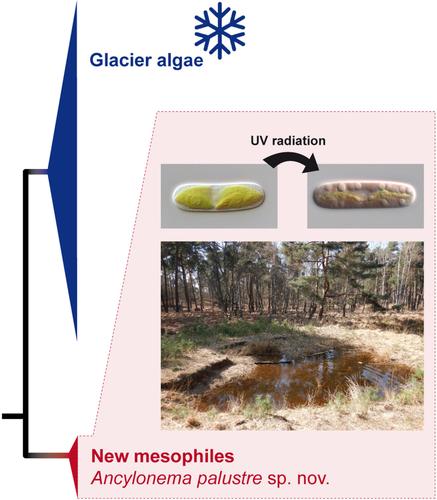当前位置:
X-MOL 学术
›
Environ. Microbiol.
›
论文详情
Our official English website, www.x-mol.net, welcomes your
feedback! (Note: you will need to create a separate account there.)
A mesophilic relative of common glacier algae, Ancylonema palustre sp. nov., provides insights into the induction of vacuolar pigments in zygnematophytes
Environmental Microbiology ( IF 4.3 ) Pub Date : 2024-07-31 , DOI: 10.1111/1462-2920.16680 Anna Busch 1 , Emilia Slominski 1 , Daniel Remias 2 , Lenka Procházková 3 , Sebastian Hess 1, 4
Environmental Microbiology ( IF 4.3 ) Pub Date : 2024-07-31 , DOI: 10.1111/1462-2920.16680 Anna Busch 1 , Emilia Slominski 1 , Daniel Remias 2 , Lenka Procházková 3 , Sebastian Hess 1, 4
Affiliation

|
The green algae of the genus Ancylonema , which belong to the zygnematophytes, are prevalent colonizers of glaciers worldwide. They display a striking reddish‐brown pigmentation in their natural environment, due to vacuolar compounds related to gallic acid. This pigmentation causes glacier darkening when these algae bloom, leading to increased melting rates. The Ancylonema species known so far are true psychrophiles, which hinders experimental work and limits our understanding of these algae. For instance, the biosynthesis, triggering factors, and biological function of Ancylonema 's secondary pigments remain unknown. In this study, we introduce a mesophilic Ancylonema species, A. palustre sp. nov., from temperate moorlands. This species forms the sister lineage to all known psychrophilic strains. Despite its morphological similarity to the latter, it exhibits unique autecological and photophysiological characteristics. It allows us to describe vegetative and sexual cellular processes in great detail. We also conducted experimental tests for abiotic factors that induce the secondary pigments of zygnematophytes. We found that low nutrient conditions combined with ultraviolet B radiation result in vacuolar pigmentation, suggesting a sunscreen function. Our thriving, bacteria‐free cultures of Ancylonema palustre will enable comparative genomic studies of mesophilic and extremophilic zygnematophytes. These studies may provide insights into how Ancylonema species colonized the world's glaciers.
中文翻译:

常见冰川藻类的嗜温近亲,Ancylonema palustre sp。十一月,提供了对接合植物中液泡色素诱导的见解
绿藻属钩线虫属于接合植物,是世界范围内冰川的普遍殖民者。由于与没食子酸相关的液泡化合物,它们在自然环境中表现出引人注目的红棕色色素沉着。当这些藻类大量繁殖时,这种色素沉着会导致冰川变黑,从而导致融化速度加快。这钩线虫迄今为止已知的物种是真正的嗜冷生物,这阻碍了实验工作并限制了我们对这些藻类的理解。例如,生物合成、触发因素和生物功能钩线虫的次要颜料仍然未知。在这项研究中,我们引入了一种嗜温钩线虫物种, A. 沼泽sp。十一月,来自温带荒原。该物种与所有已知的嗜冷菌株形成姐妹谱系。尽管其形态与后者相似,但它表现出独特的自生态学和光生理学特征。它使我们能够详细描述营养和性细胞过程。我们还对诱导接合菌次生色素的非生物因素进行了实验测试。我们发现,低营养条件与紫外线 B 辐射相结合会导致空泡色素沉着,表明具有防晒功能。我们蓬勃发展的无菌文化沼泽钩线虫将使嗜温和极嗜接合植物的比较基因组研究成为可能。这些研究可能会提供有关如何钩线虫物种在世界冰川上定居。
更新日期:2024-07-31
中文翻译:

常见冰川藻类的嗜温近亲,Ancylonema palustre sp。十一月,提供了对接合植物中液泡色素诱导的见解
绿藻属钩线虫属于接合植物,是世界范围内冰川的普遍殖民者。由于与没食子酸相关的液泡化合物,它们在自然环境中表现出引人注目的红棕色色素沉着。当这些藻类大量繁殖时,这种色素沉着会导致冰川变黑,从而导致融化速度加快。这钩线虫迄今为止已知的物种是真正的嗜冷生物,这阻碍了实验工作并限制了我们对这些藻类的理解。例如,生物合成、触发因素和生物功能钩线虫的次要颜料仍然未知。在这项研究中,我们引入了一种嗜温钩线虫物种, A. 沼泽sp。十一月,来自温带荒原。该物种与所有已知的嗜冷菌株形成姐妹谱系。尽管其形态与后者相似,但它表现出独特的自生态学和光生理学特征。它使我们能够详细描述营养和性细胞过程。我们还对诱导接合菌次生色素的非生物因素进行了实验测试。我们发现,低营养条件与紫外线 B 辐射相结合会导致空泡色素沉着,表明具有防晒功能。我们蓬勃发展的无菌文化沼泽钩线虫将使嗜温和极嗜接合植物的比较基因组研究成为可能。这些研究可能会提供有关如何钩线虫物种在世界冰川上定居。


















































 京公网安备 11010802027423号
京公网安备 11010802027423号